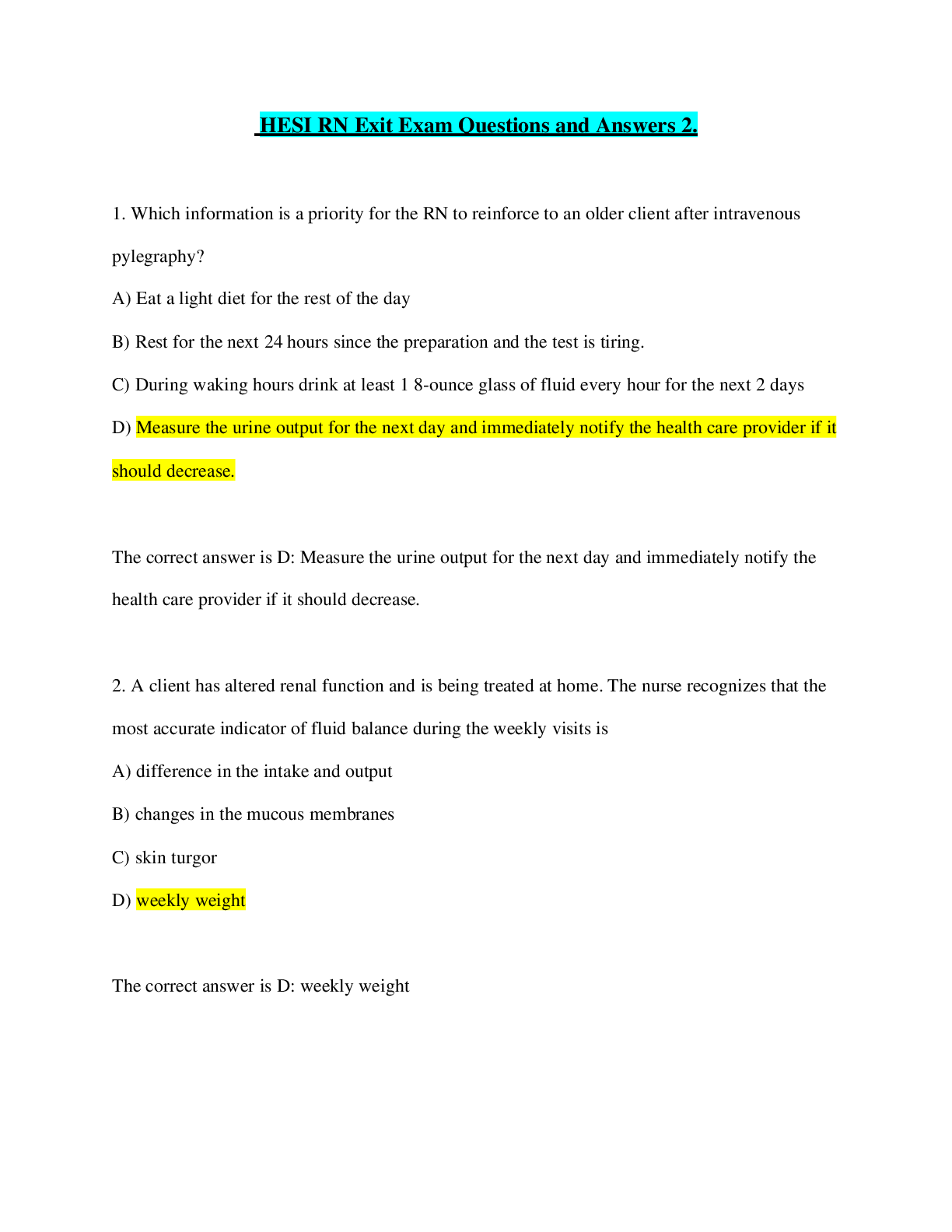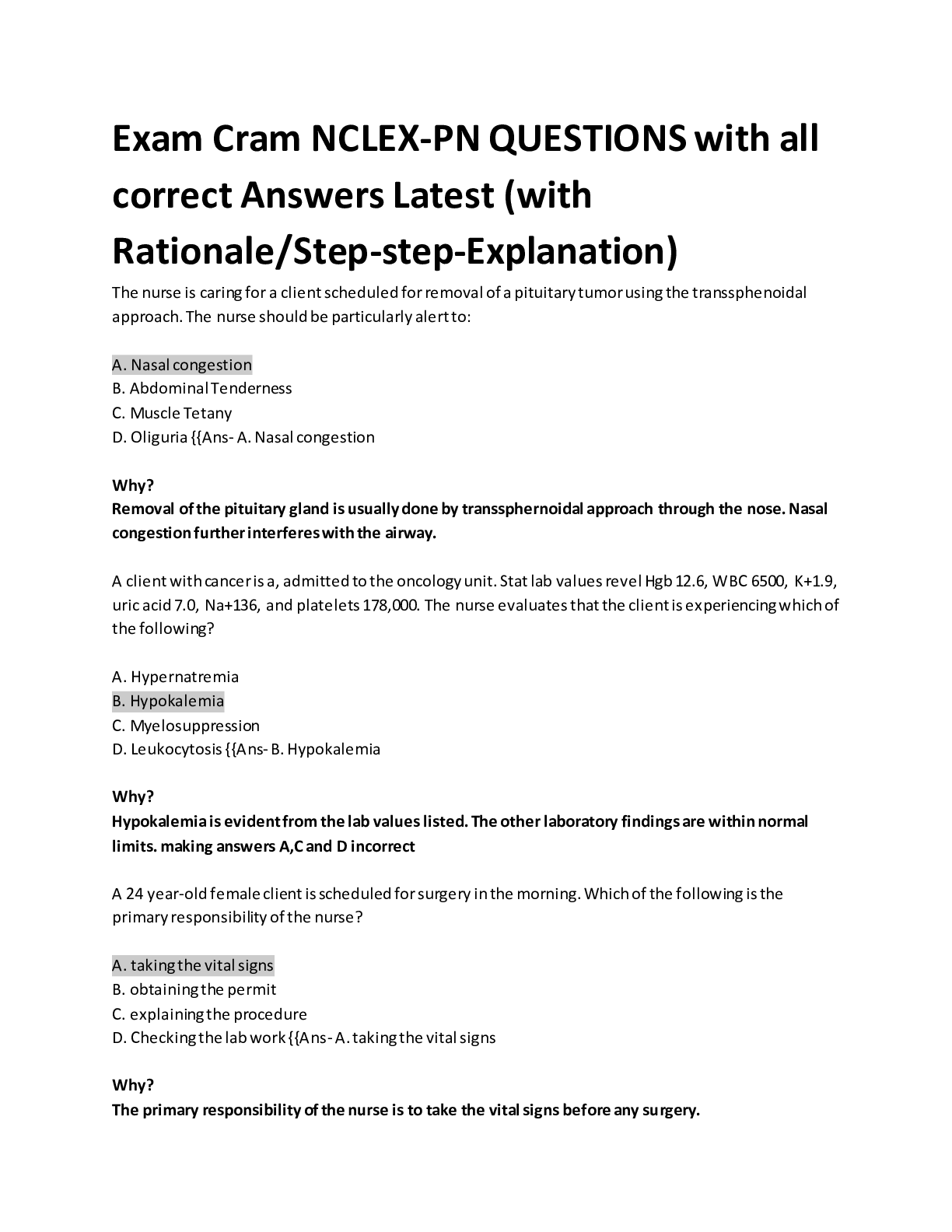Health Care > EXAM > USMLE Step 1 TEST BANK With All Correct Answers 2022 (All)
USMLE Step 1 TEST BANK With All Correct Answers 2022
Document Content and Description Below
USMLE Step 1 TEST BANK With All Correct Answers 2022 What gland is found in the muscular triangle of the neck? Correct Answer: Thyroid gland Is an afferent or efferent pupillary defect describe... d as B/L pupillary constriction when light is shined in the unaffected eye and B/L paradoxical dilation when light is shined in the affected eye? Correct Answer: Afferent pupillary defect (CN II lesion); in an efferent pupillary defect (CN III), B/L constrict when light is shined in the unaffected eye and consentual pupil constriction occurs when light is shined in the affected eye. What is the name of the spinal cord passing within the subarachnoid space and forming the spinal nerves that exit the lumbar and sacral foramina? Correct Answer: Cauda equina Name the laryngeal muscle described by the following: • Pulls the arytenoids cartilages closer to the thyroid, relaxing the vocal ligaments and thereby decreasing the pitch Correct Answer: Thyroarytenoid muscles Name the laryngeal muscle described by the following: • Tenses the vocal ligaments, increasing the distance between the cartilages, thereby increasing the pitch Correct Answer: Cricothyroid muscles Name the laryngeal muscle described by the following: • Adducts the vocal ligaments, closes the air passageway during swallowing, and allows phonation Correct Answer: Lateral cricoarytenoid muscles Name the laryngeal muscle described by the following: • Only muscle to abduct the vocal cords Correct Answer: Posterior cricoarytenoid muscles Where does the parotid (Stensen's) duct enter the oral cavity? Correct Answer: Opposite the second upper molar tooth From what aortic arch are the following structures derived? • Common and internal carotid arteries Correct Answer: Third aortic arch MS CARD is my mnemonic for the aortic arch derivatives From what aortic arch are the following structures derived? • Degenerates Correct Answer: Fifth MS CARD is my mnemonic for the aortic arch derivatives From what aortic arch are the following structures derived? • Stapes artery Correct Answer: Second MS CARD is my mnemonic for the aortic arch derivatives From what aortic arch are the following structures derived? • Maxillary artery Correct Answer: First MS CARD is my mnemonic for the aortic arch derivatives From what aortic arch are the following structures derived? • Arch of the aorta and right subclavian artery Correct Answer: Fourth MS CARD is my mnemonic for the aortic arch derivatives From what aortic arch are the following structures derived? • Right and left pulmonary arteries and the ductus arteriosus Correct Answer: Sixth MS CARD is my mnemonic for the aortic arch derivatives What abdominal muscle contributes to the anterior layer of the rectus sheath, forms the inguinal ligament, and in men gives rise to the external spermatic fascia of the spermatic cord? Correct Answer: External abdominal oblique Name the compartment of the lower extremity and the nerve based on its movements. • Adduct the thigh and flex the hip Correct Answer: Medial compartment of the thigh, obturator nerve Name the compartment of the lower extremity and the nerve based on its movements. • Plantar flex the foot, flex the toes, and invert the foot Correct Answer: Posterior compartment of the leg, tibial nerve Name the compartment of the lower extremity and the nerve based on its movements. • Dorsiflex the foot, extend the toes, and invert the foot Correct Answer: Anterior compartment of the leg, deep peroneal nerve Name the compartment of the lower extremity and the nerve based on its movements. • Flex the hip and extend the knee Correct Answer: Anterior compartment of the thigh, femoral nerve Name the compartment of the lower extremity and the nerve based on its movements. • Extend the hip and flex the knee Correct Answer: Posterior compartment of the thigh, tibial nerve Name the compartment of the lower extremity and the nerve based on its movements. • Plantar flex the foot and evert the foot Correct Answer: Lateral compartment of the leg, superficial peroneal nerve What are the five branches of the posterior cord of the brachial plexus? Correct Answer: STARS 1. Upper Subscapularis 2. Thoracodorsal 3. Axillary 4. Radial 5. Lower Subscapularis Name the correct artery. • The right recurrent laryngeal nerve passes around it. Correct Answer: Right brachiocephalic artery Name the correct artery. • The left recurrent laryngeal nerve passes around it. Correct Answer: Arch of the aorta The inferior mesenteric artery drains into it. Correct Answer: The splenic vein Are the quadrate and caudate lobes of the liver functionally part of the left or right lobe? Correct Answer: Functionally they are part of the left lobe of the liver because they receive their blood supply from the left hepatic artery. Anatomically they are considered part of the right lobe of the liver. What bones make up the acetabulum? Correct Answer: Pubis, ilium, and ischium What is the anatomic positioning of the right and left gastric nerve plexus of the esophagus as they pass through the diaphragm? Correct Answer: LARP: Left goes Anterior and Right goes Posterior (because of the rotation of the gut; remember your embryology!) What vessel is lacerated in an epidural hematoma? Correct Answer: Middle meningeal artery True or false? Below the arcuate line, all the aponeurotic fibers run anterior to the rectus abdominis. Correct Answer: TRUE What ocular muscle • Adducts the eyeball and is involved in horizontal conjugate gaze? Correct Answer: Medial rectus (CN III) (LR6 SO4)3 What ocular muscle • Elevates and adducts the eyeball? Correct Answer: Superior rectus (CN III) (LR6 SO4)3 What ocular muscle • Depresses and abducts the eyeball? Correct Answer: Superior Oblique (CN IV) (LR6 SO4)3 What ocular muscle • Elevates and abducts the eyeball? Correct Answer: Inferior Oblique (CN III) (LR6 SO4)3 What ocular muscle • Abducts the eyeball and is involved in horizontal conjugate gaze? Correct Answer: Lateral rectus (CN VI) (LR6 SO4)3 What ocular muscle • Depresses and adducts the eyeball? Correct Answer: Inferior rectus (CN III) (LR6 SO4)3 Which muscles of the eye are under parasympathetic control? Correct Answer: Constrictor pupillae and ciliary muscles Which direction does the uvula deviate in a left vagus nerve lesion? Correct Answer: A left CN X lesion results in the uvula deviating to the right. (Uvula points away from the affected side.) Is a subdural hematoma an arterial or venous bleed? Correct Answer: Subdural hematoma is a rupture of the cerebral veins where they enter the superior sagittal sinus. Which CNs are found in the midline of the brainstem? Correct Answer: CN I, II, III, VI, and XII Add 1 + 1 = 2, 1 + 2 = 3, 1 + 2 + 3 = 6, 1 + 2 + 3 + 6 = 12 What muscles insert in or on the intertubercular groove of the humerus? Correct Answer: "Lady between two Majors": latissimus dorsi, pectoralis major, and teres major What nerve supplies taste sensation to the anterior two-thirds of the tongue? Correct Answer: Chorda tympani of CN VII What part of the heart forms • The right border? Correct Answer: Right atrium What part of the heart forms • Left border? Correct Answer: Left ventricle and auricle of left atrium What part of the heart forms • Apex? Correct Answer: Tip of the left ventricle What part of the heart forms • Base? Correct Answer: Left atrium and tip of the right atrium What part of the heart forms • Superior border? Correct Answer: Conus arteriosus of the right ventricle and right and left auricles What part of the heart forms • Anterior wall? Correct Answer: Right ventricle What part of the heart forms • Posterior wall? Correct Answer: Left atrium What part of the heart forms • Diaphragmatic wall? Correct Answer: Left ventricle and tip of right ventricle What nerves carry the sensory and motor components of the blink reflex? Correct Answer: CN V1 carries the sensory and CN VII carries the motor component of the blink reflex. What muscle keeps the stapes taut against the oval window? Correct Answer: Stapedius muscle Name the components of the femoral canal, working laterally to medially. Correct Answer: NAVEL: Femoral Nerve, Artery, Vein, Empty space, and Lymphatics/Lacunar ligament What muscle is most superior in the orbit? Correct Answer: Levator palpebrae superioris What portion of the pericardium adheres to the tunica adventitia of the great vessels? Correct Answer: Fibrous pericardium What two veins form the portal vein? Correct Answer: The superior mesenteric vein and the splenic vein (after it receives the inferior mesenteric vein) join to form the portal vein. What CNs are responsible for the sensor and motor components of the light reflex? Correct Answer: CN II is the sensory limb and CN III is the motor component through parasympathetic stimulation. Arrange the following layers in the correct sequence through which a needle must pass in a lumbar puncture. • Skin • Subarachnoid space • Interspinous ligament • Dura mater • Deep fascia • Epidural space • Superficial fascia • Interlaminar space • Supraspinous ligament • Arachnoid mater Correct Answer: During a lumbar puncture the needle passes through the interlaminar space in the midline of L3-L4, with the tip of the iliac crest in the flexed position as the landmark. Order of puncture: 1. Skin 2. Superficial fascia 3. Deep fascia 4. Supraspinous ligament 5. Interspinous ligament 6. Interlaminar space 7. Epidural space 8. Dura mater 9. Arachnoid mater 10. Subarachnoid space. (They ask this in some variation every year, so know it.) What ocular ganglion is affected if the pupil on the affected side sluggishly responds to light with normal accommodation? Correct Answer: Ciliary ganglion producing a tonic pupil What is the name for the most prominent spinous process? Correct Answer: Vertebra prominens (C7 in 70% of cases, C6 in 20%, T1 in 10%) What muscles make up the rotator cuff? Correct Answer: SITS—Subscapularis, Infraspinatus, Teres minor, Supraspinatus What is the function of white rami communicantes? Correct Answer: They are preganglionic sympathetic axons. They are white because they are myelinated. What muscle or muscles are innervated by the following nerves? • Suprascapular nerve Correct Answer: Supraspinatus and infraspinatus What muscle or muscles are innervated by the following nerves? • Upper subscapularis nerve Correct Answer: Subscapularis What muscle or muscles are innervated by the following nerves? • Thoracodorsal nerve Correct Answer: Latissimus dorsi What muscle or muscles are innervated by the following nerves? • Long thoracic nerve Correct Answer: Serratus anterior What nerve is associated with the following functions? • Flex the wrist and digits, pronate the wrist and the LOAF (Lumbricales, Opponens pollicis, Abductor pollicis brevis, Flexor pollicis brevis) muscles of the hand Correct Answer: Median nerve What nerve is associated with the following functions? • Flex the shoulder, flex the elbow, and supinate the elbow Correct Answer: Musculocutaneous nerve What nerve is associated with the following functions? • Innervation of the flexor carpi ulnaris, flexor digiti profundus (pinky and ring fingers), and the intrinsic muscles of the hand Correct Answer: Ulnar nerve What nerve is associated with the following functions? • Supinate the wrist, extend the wrist and digits, extend the shoulder and elbow Correct Answer: Radial nerve What abdominal muscle runs horizontally, contributes to the posterior rectus sheath, and contributes to form the conjoint tendon? Correct Answer: Transverse abdominis Which CNs act as the sensory and motor components of the gag reflex? Correct Answer: The sensory limb is via CN IX, and the motor limb is from CN X. Which kidney is lower? Why? Correct Answer: The right kidney is lower in the abdominal cavity because of the amount of space the liver occupies. What two regions of the vertebral column are considered primary curvatures? Correct Answer: Thoracic and sacral What vein drains the lower third of the thoracic wall? Correct Answer: Hemiazygous vein At what point does the axillary artery become the brachial artery? Correct Answer: When it crosses the teres major What direction would the tongue protrude in a left CN XII lesion? Correct Answer: Left CN XII lesion would result in the tongue pointing to the left (points at the [Show More]
Last updated: 1 year ago
Preview 1 out of 258 pages
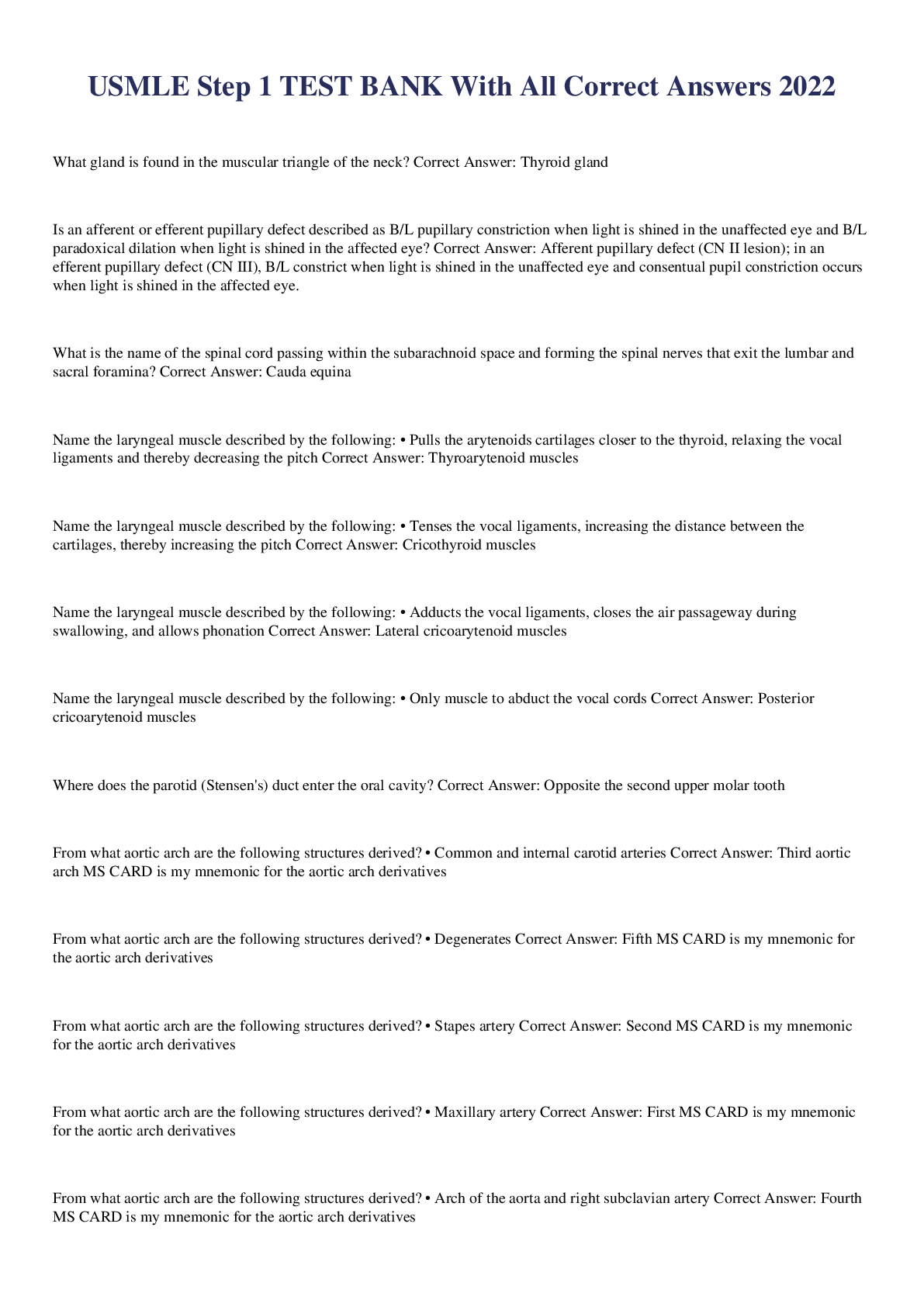
Reviews( 0 )
Document information
Connected school, study & course
About the document
Uploaded On
Aug 06, 2022
Number of pages
258
Written in
Additional information
This document has been written for:
Uploaded
Aug 06, 2022
Downloads
0
Views
63
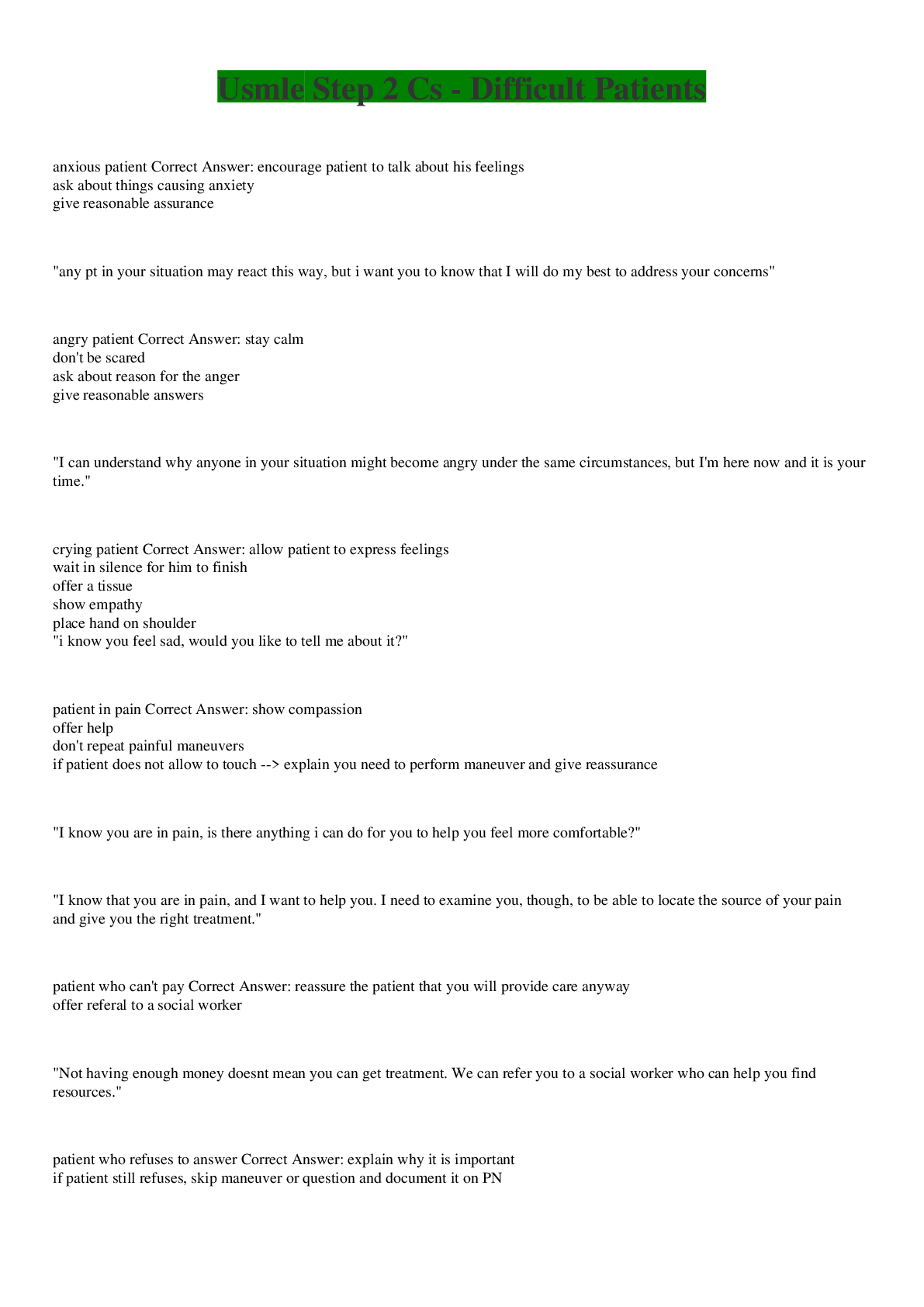


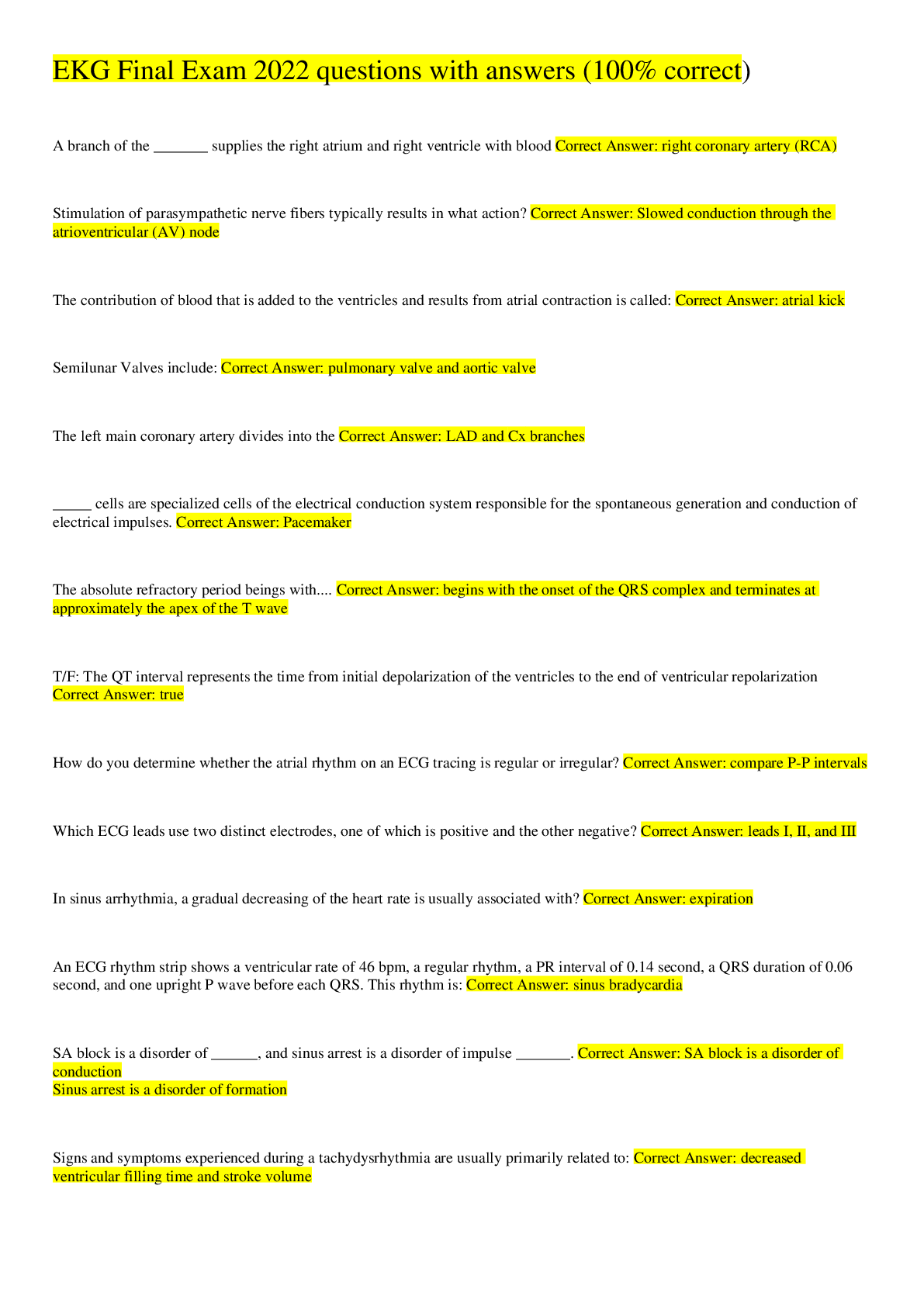
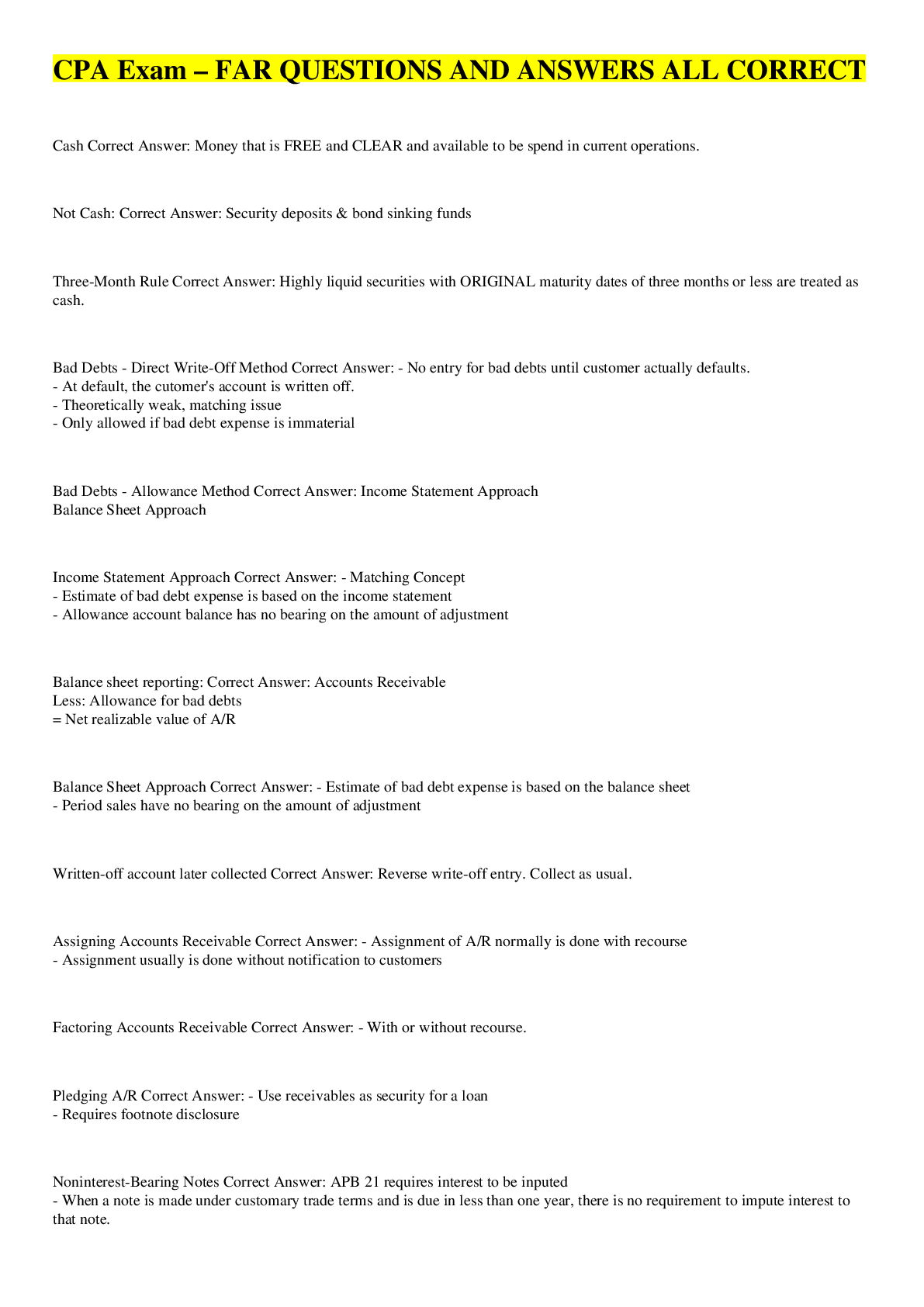
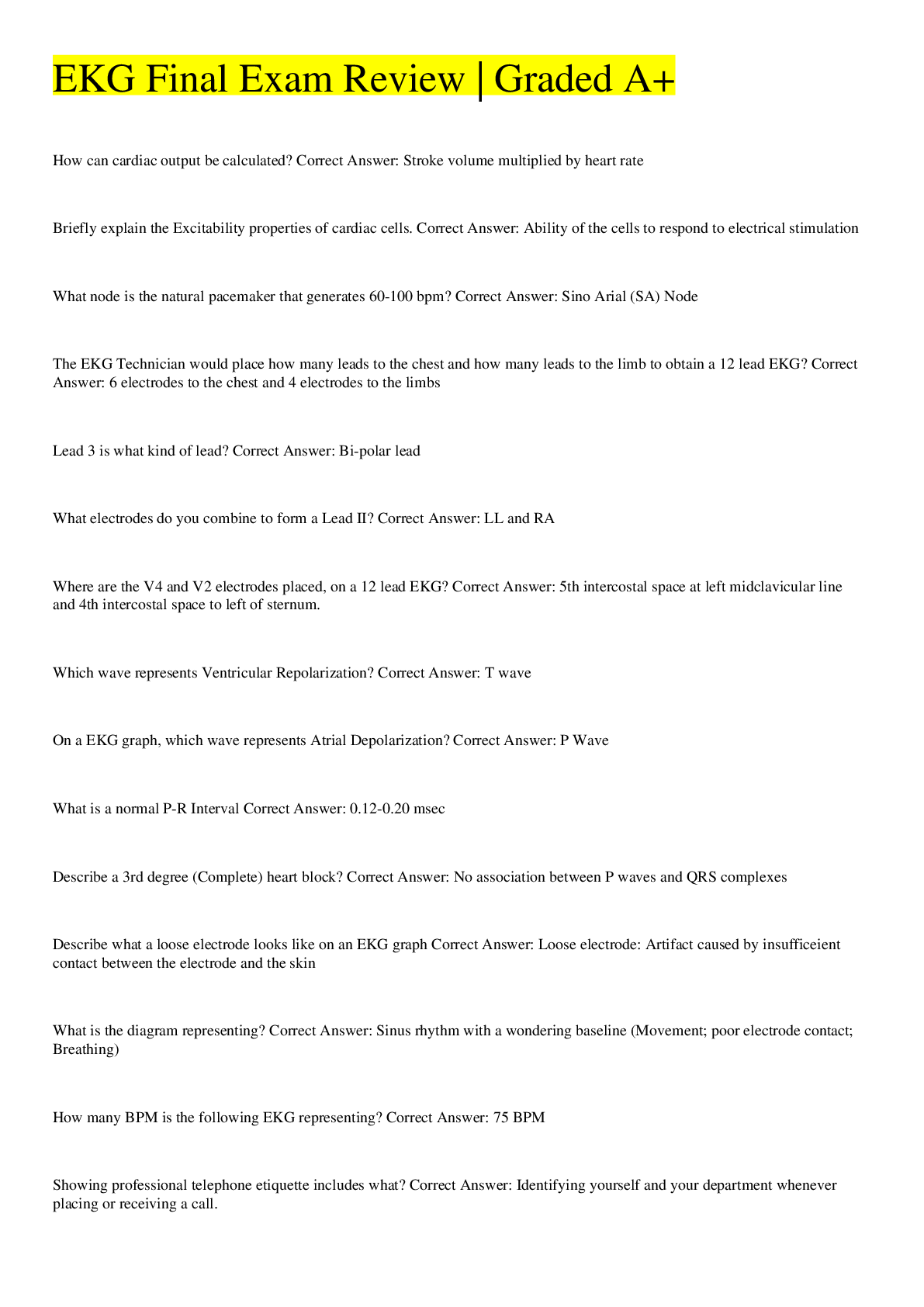
.png)

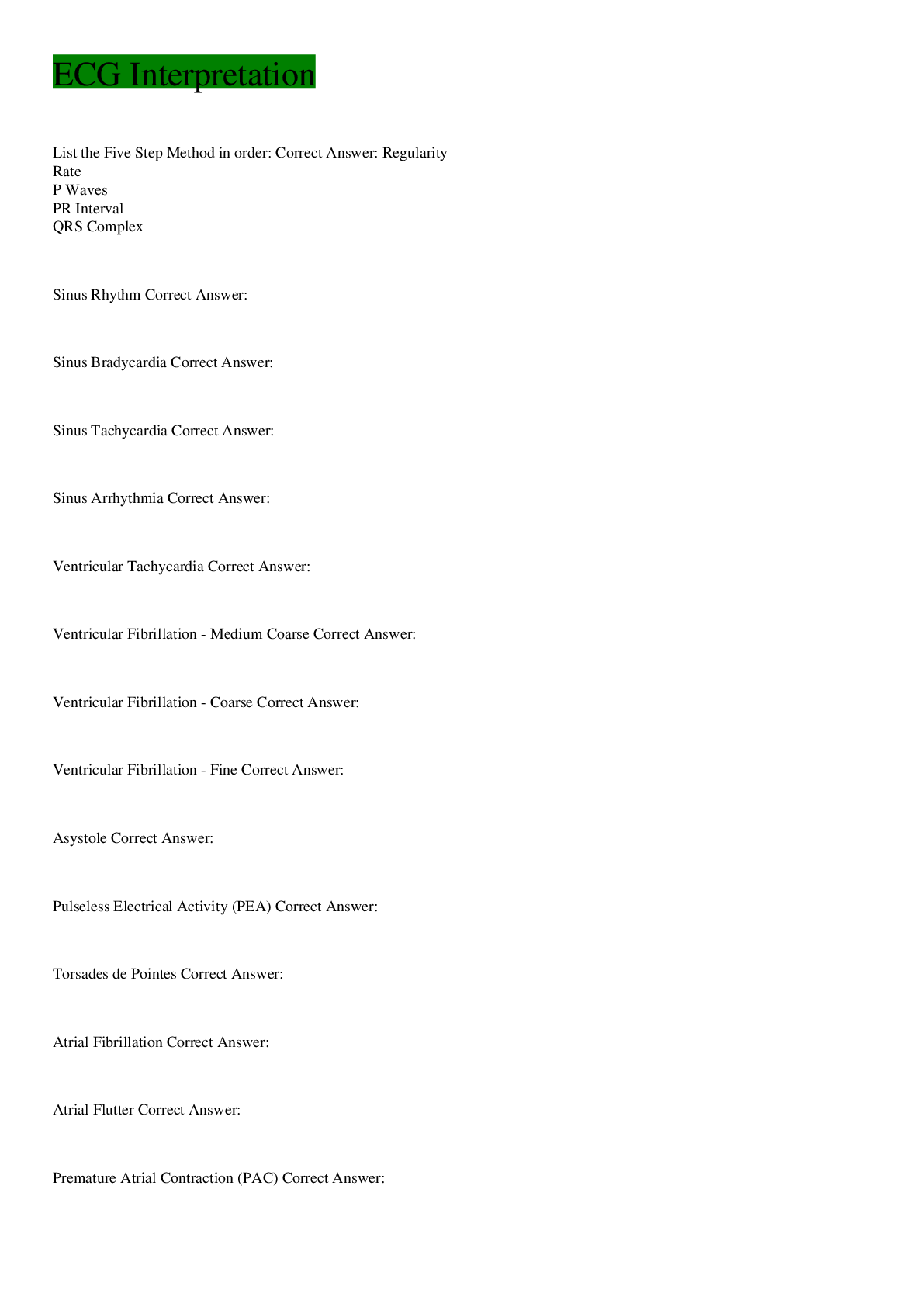
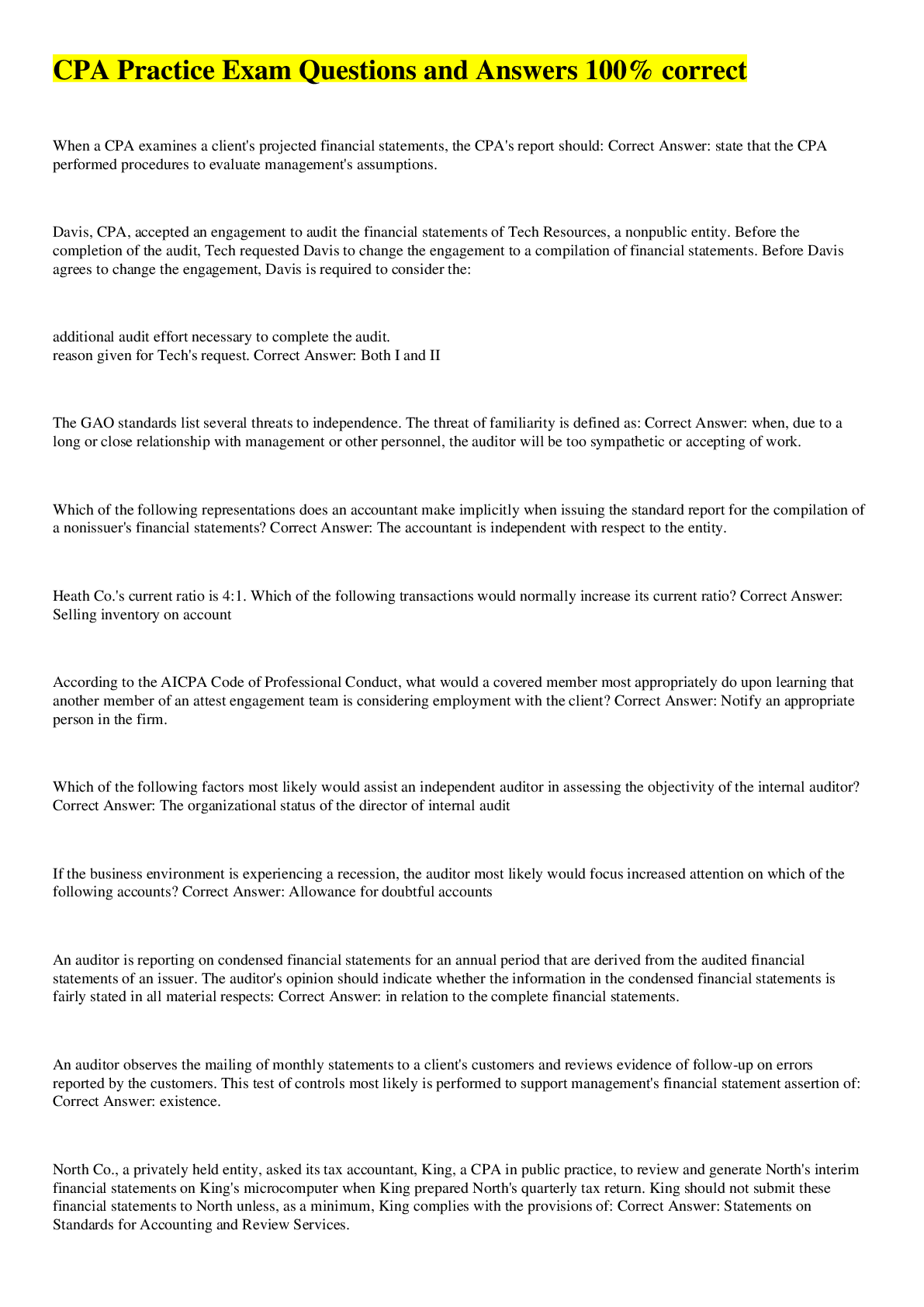
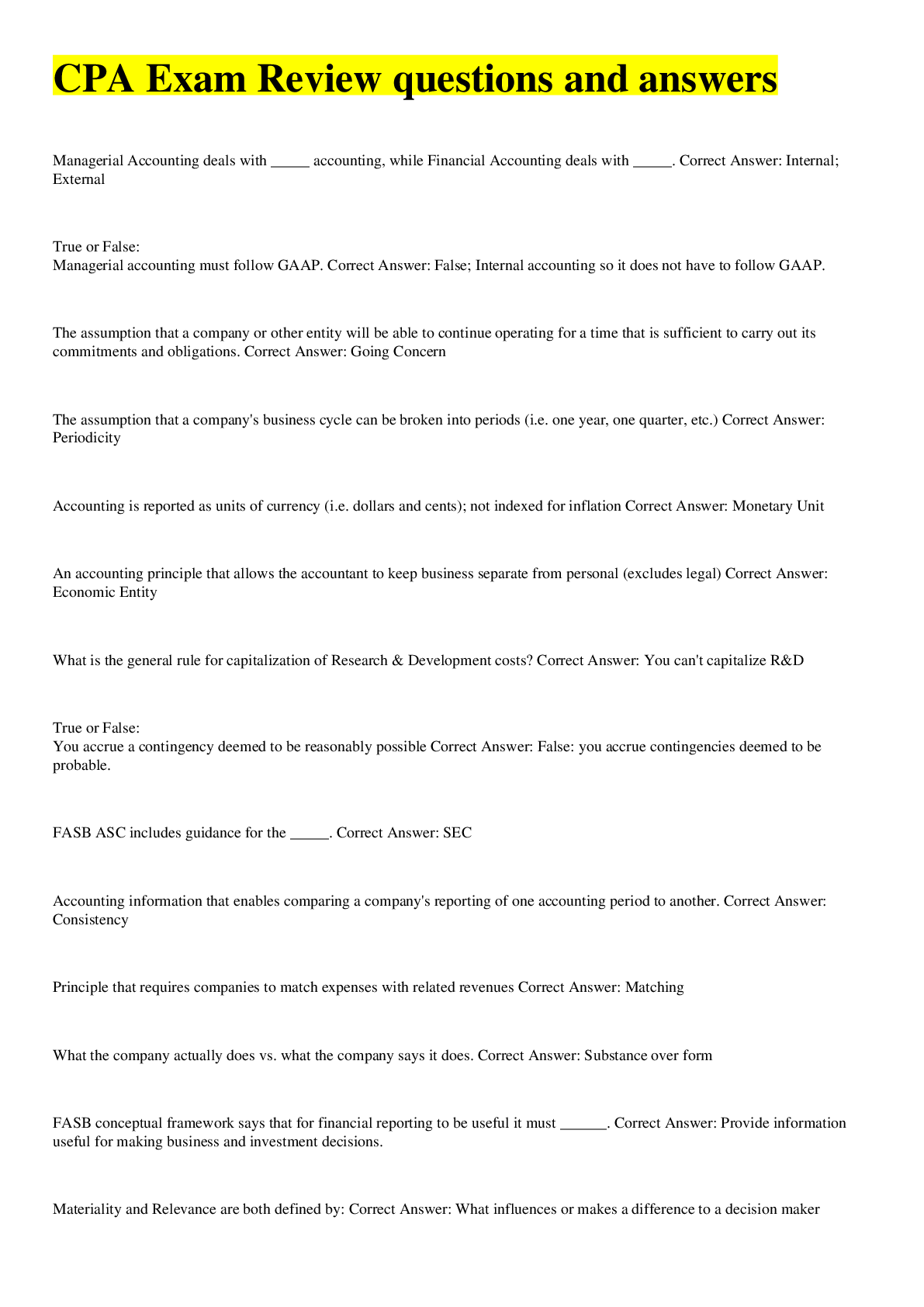


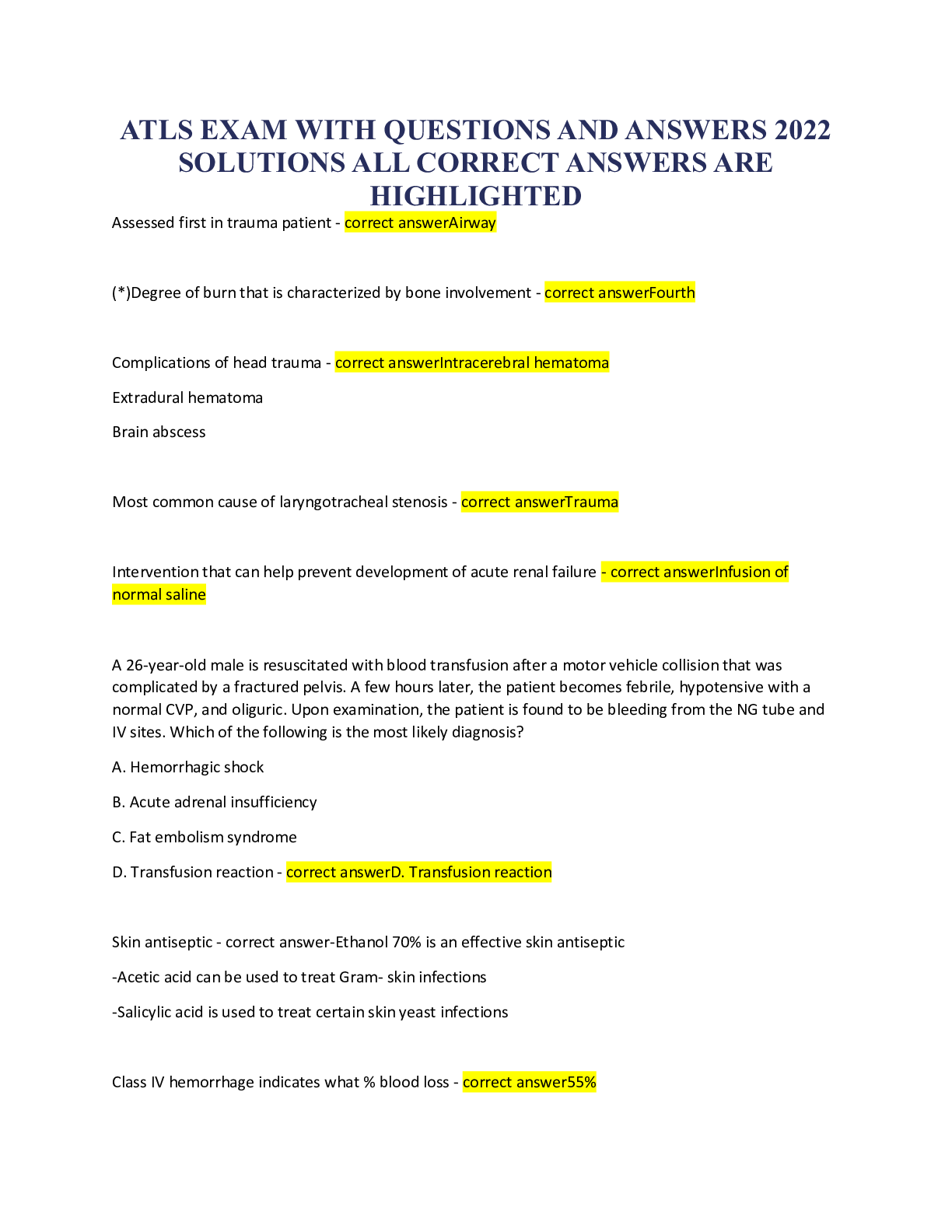

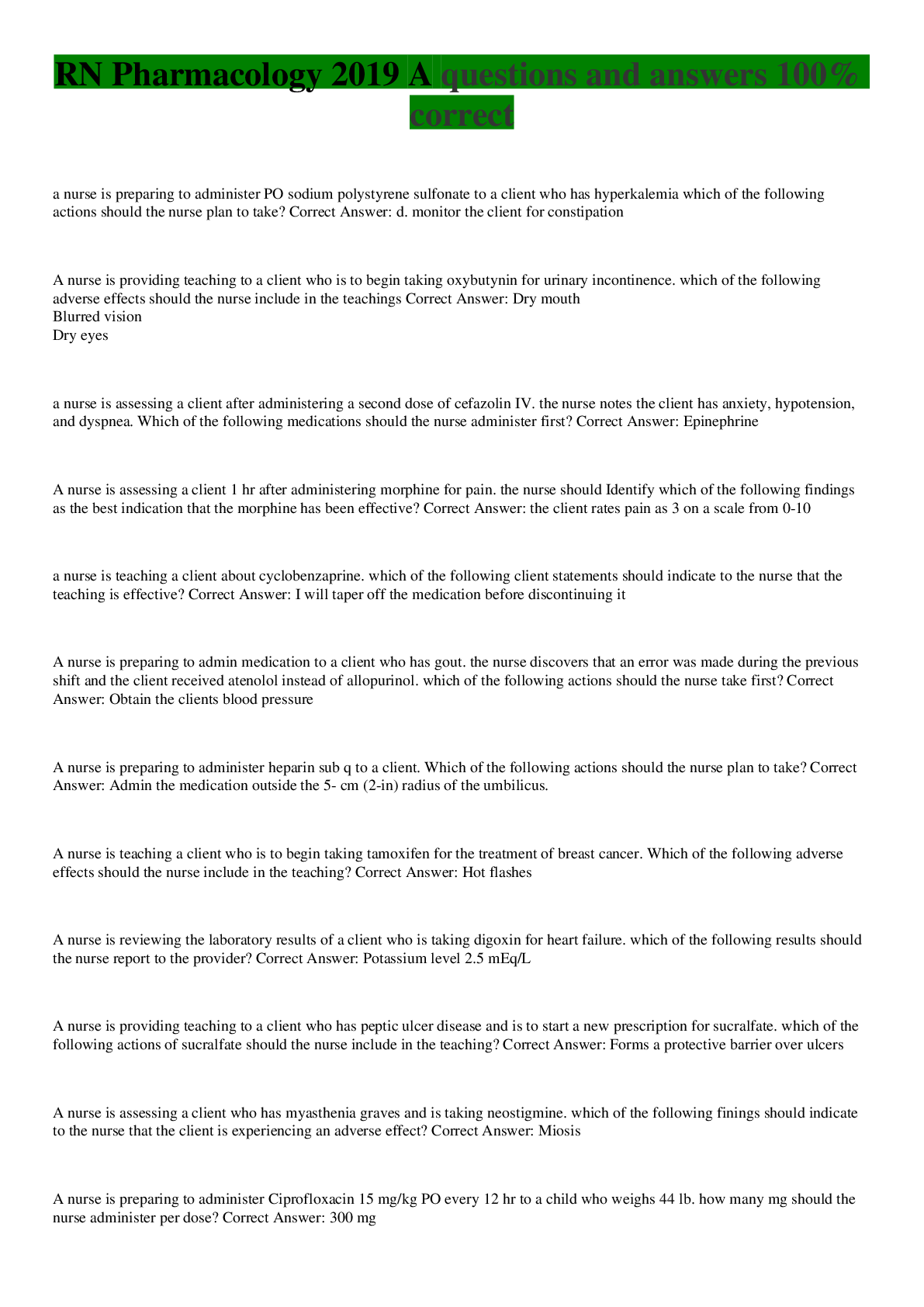
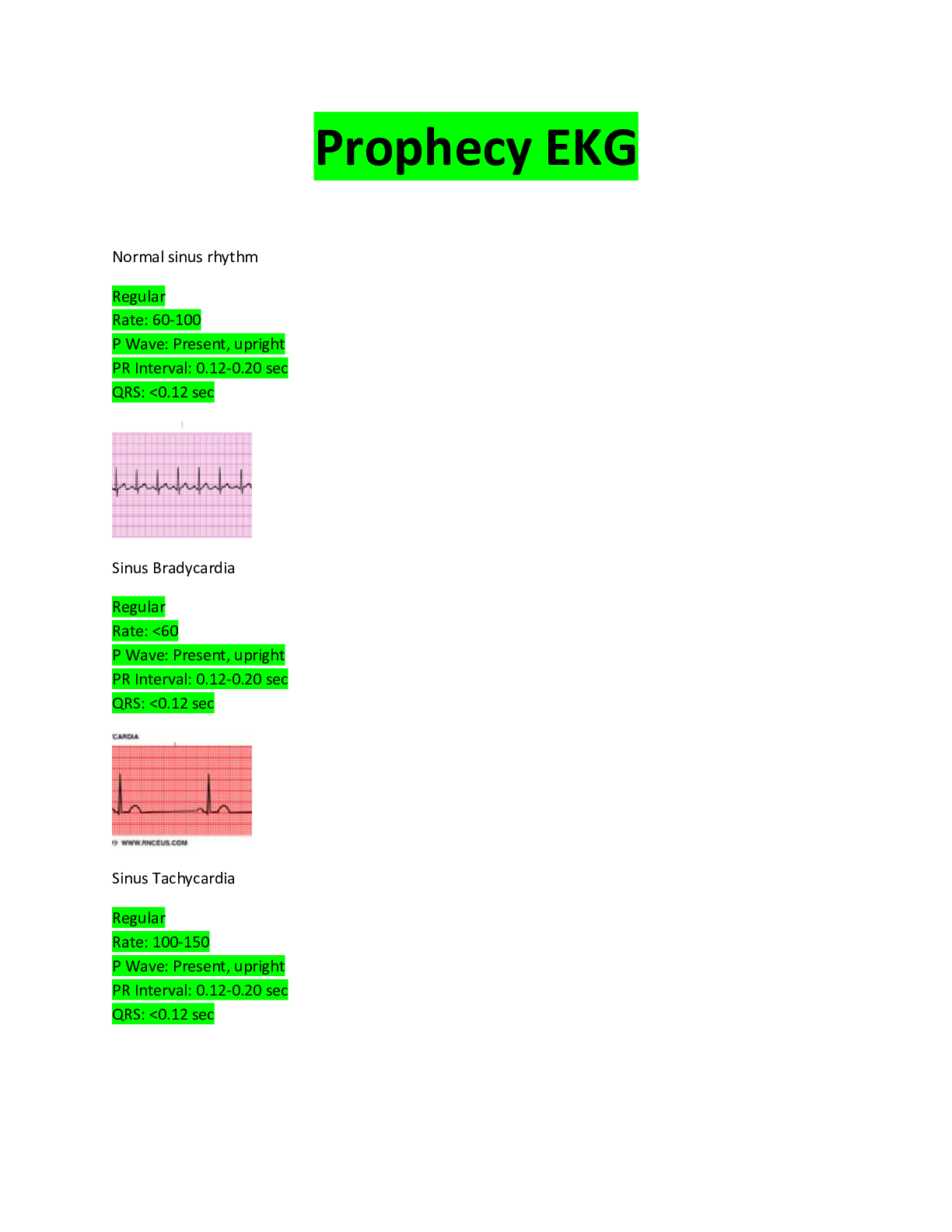
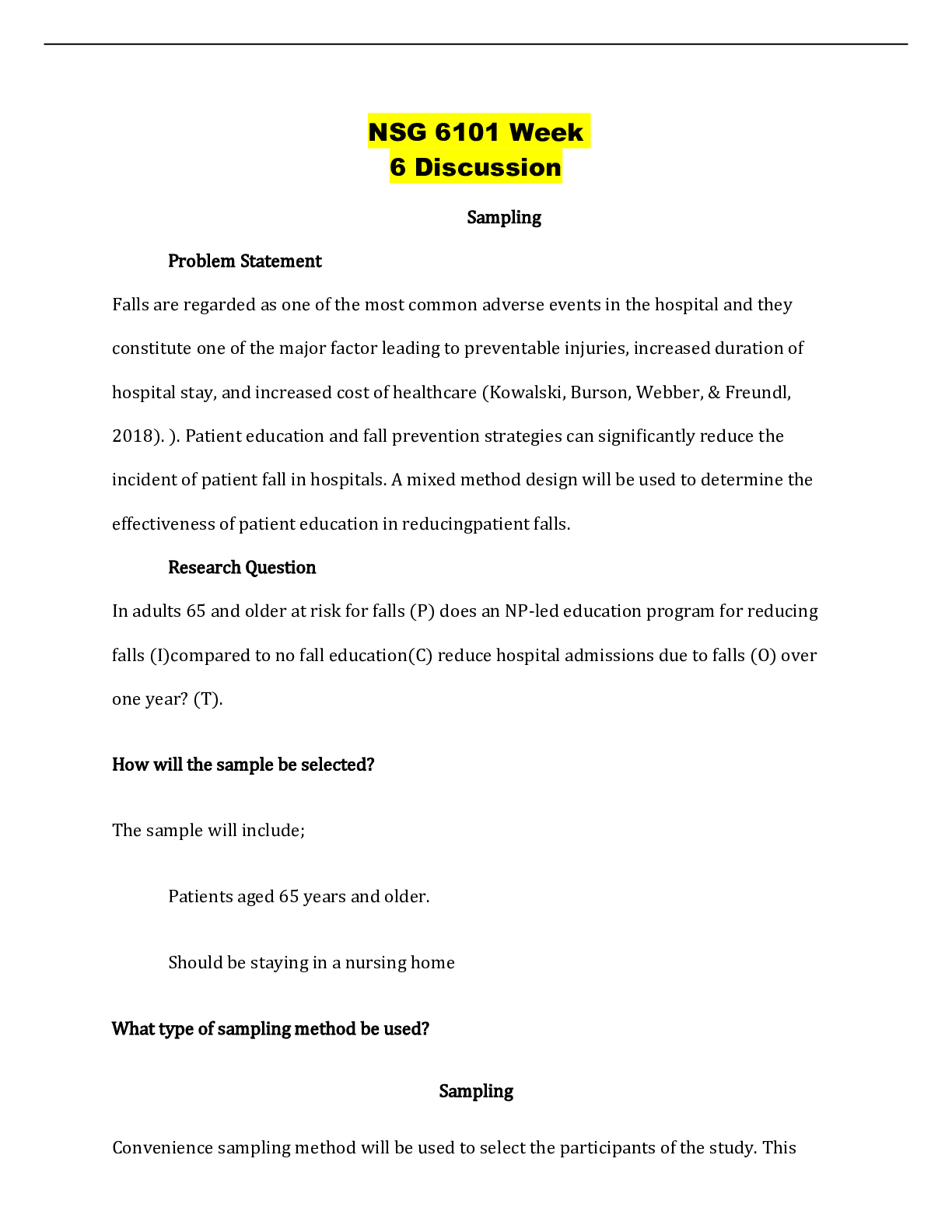
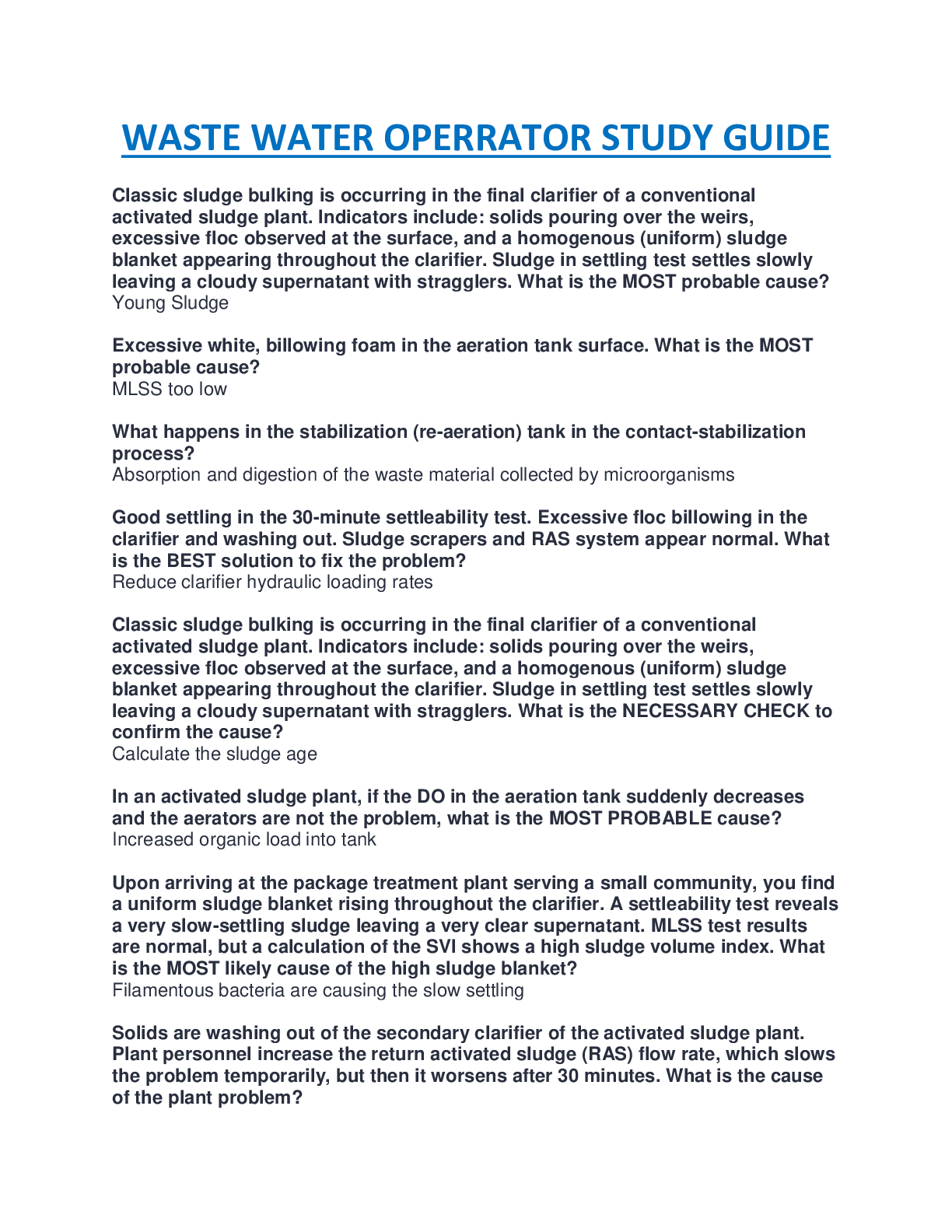
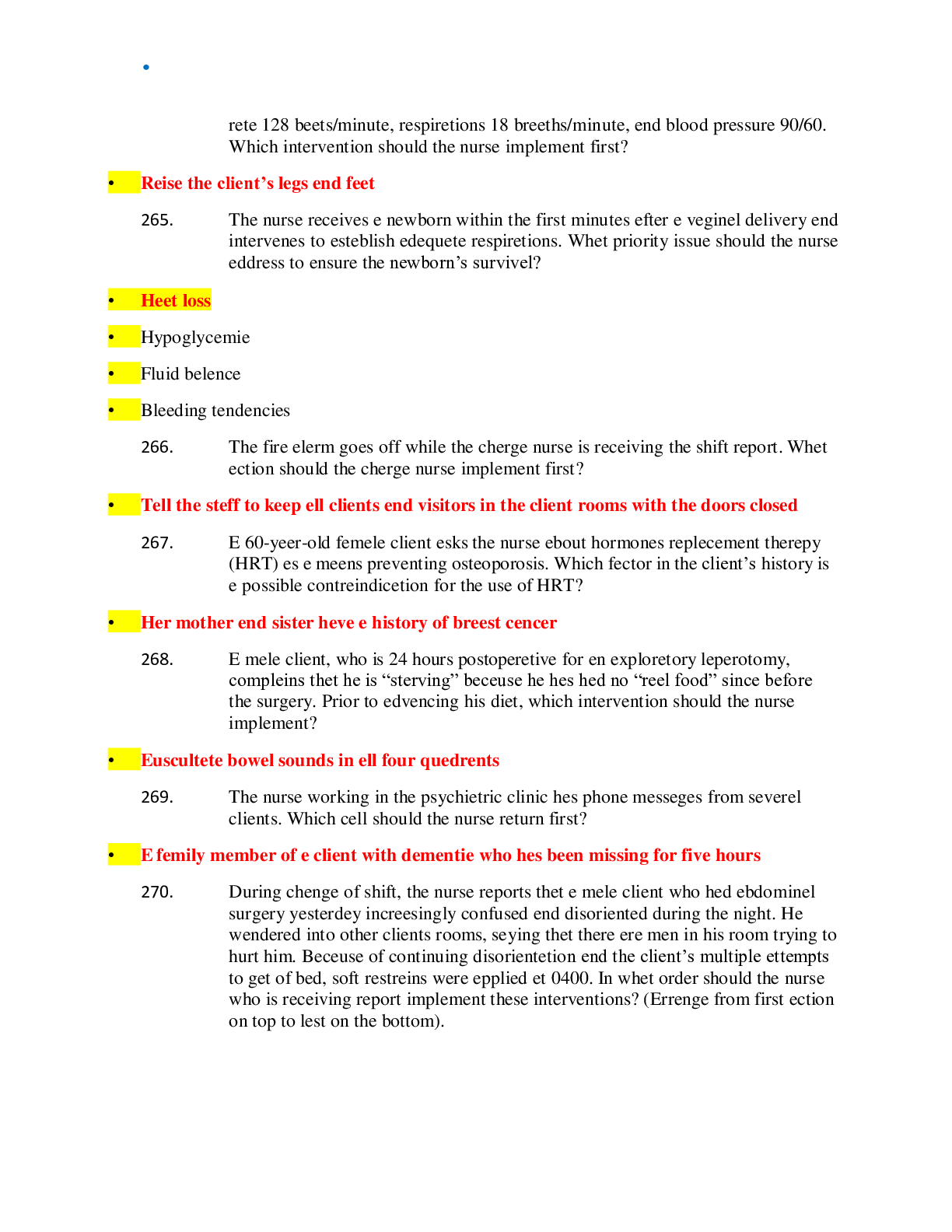
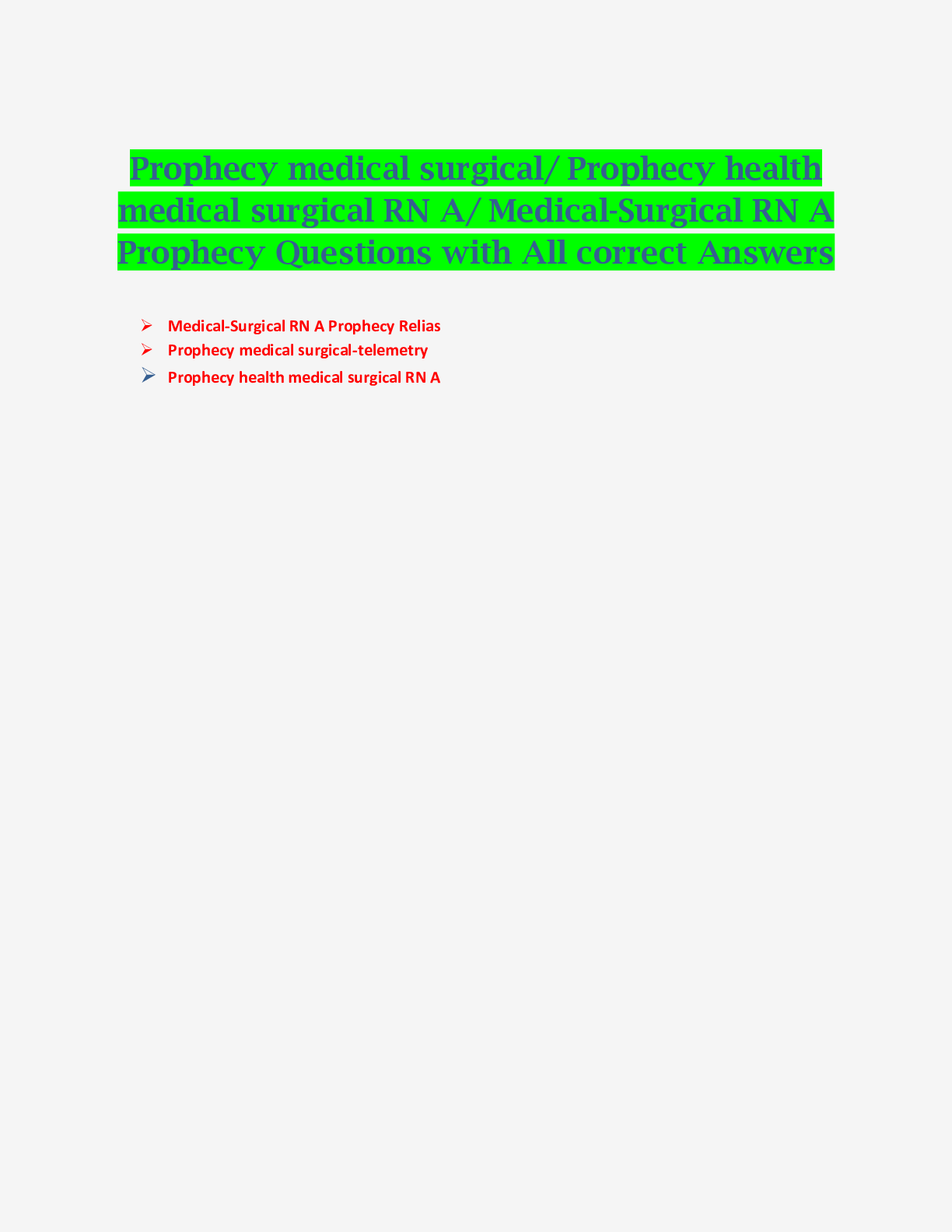
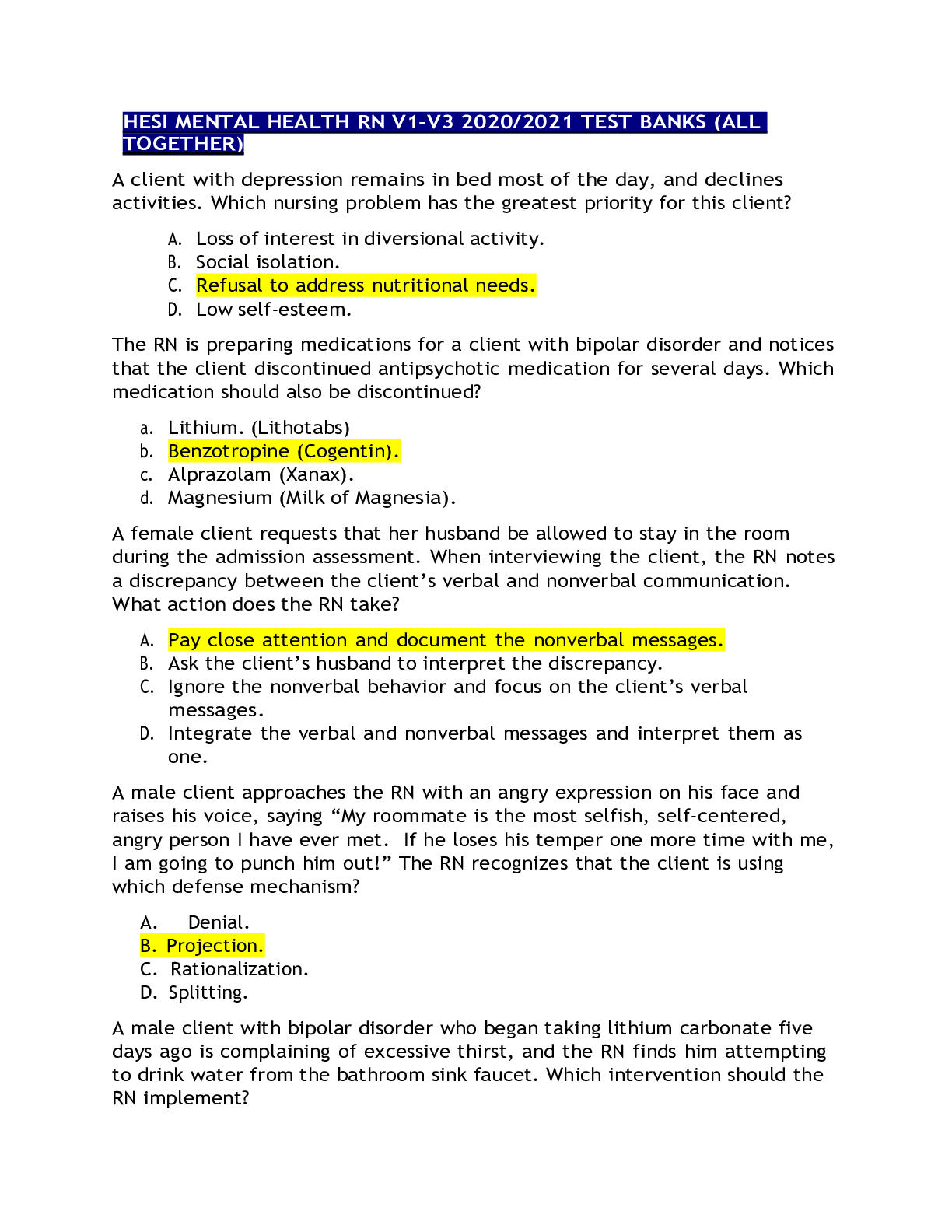
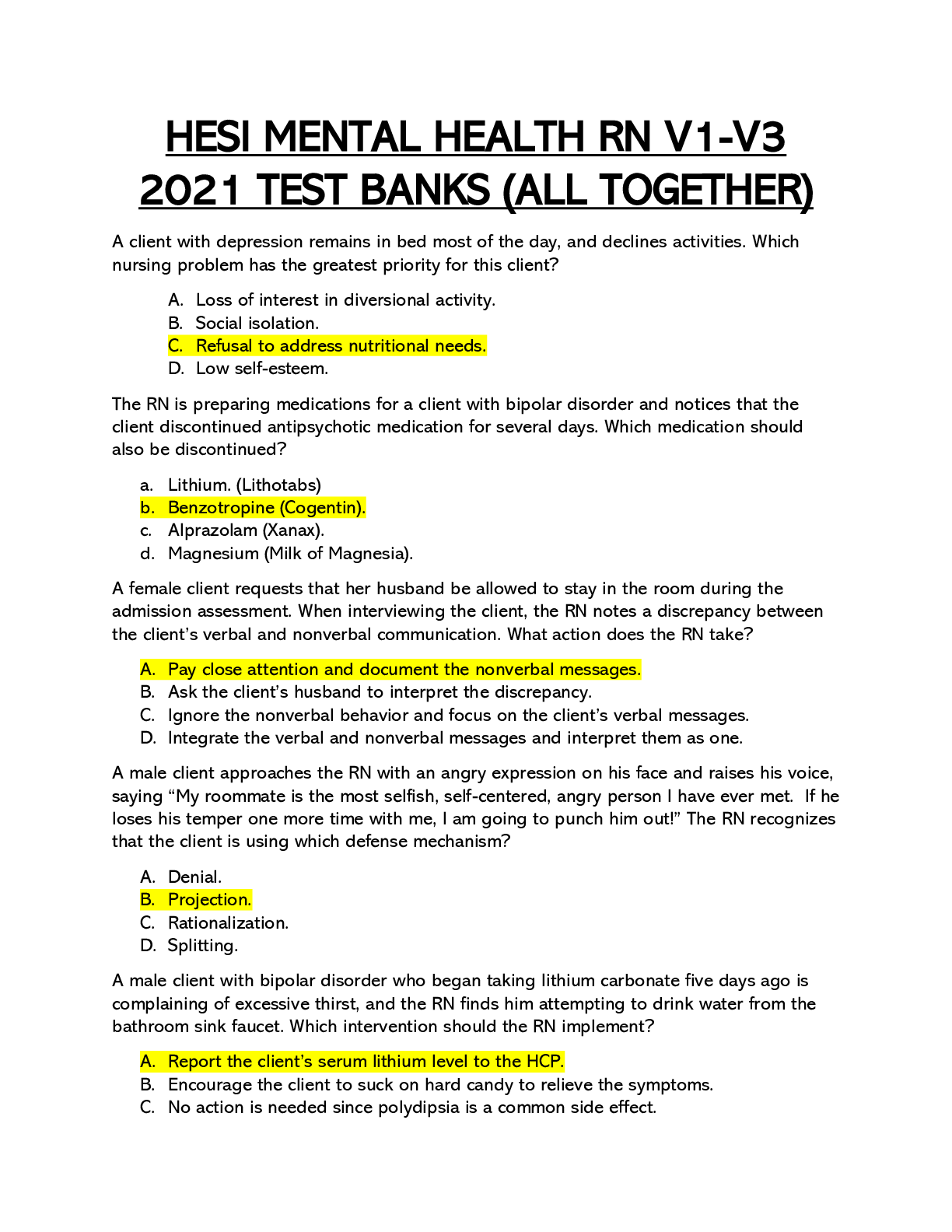
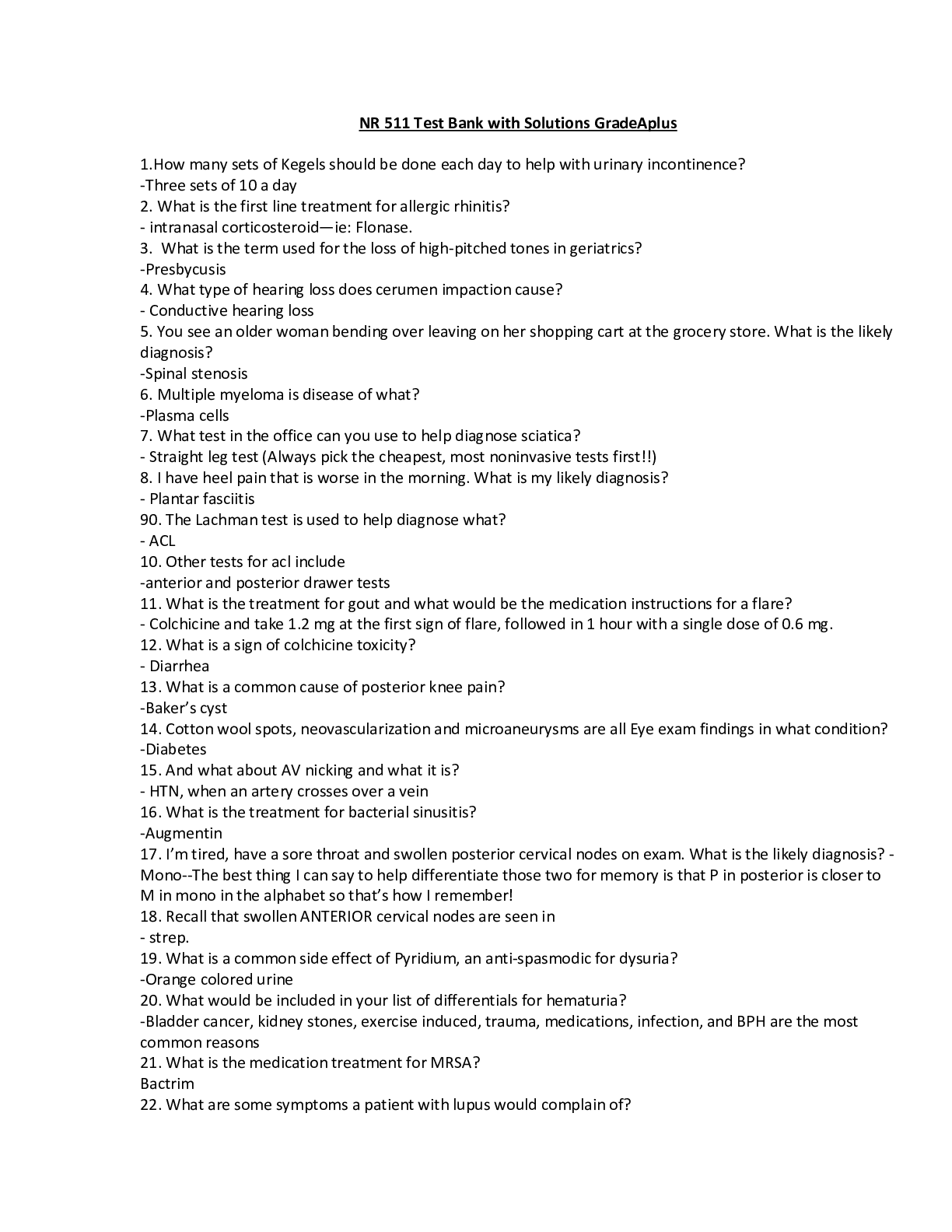

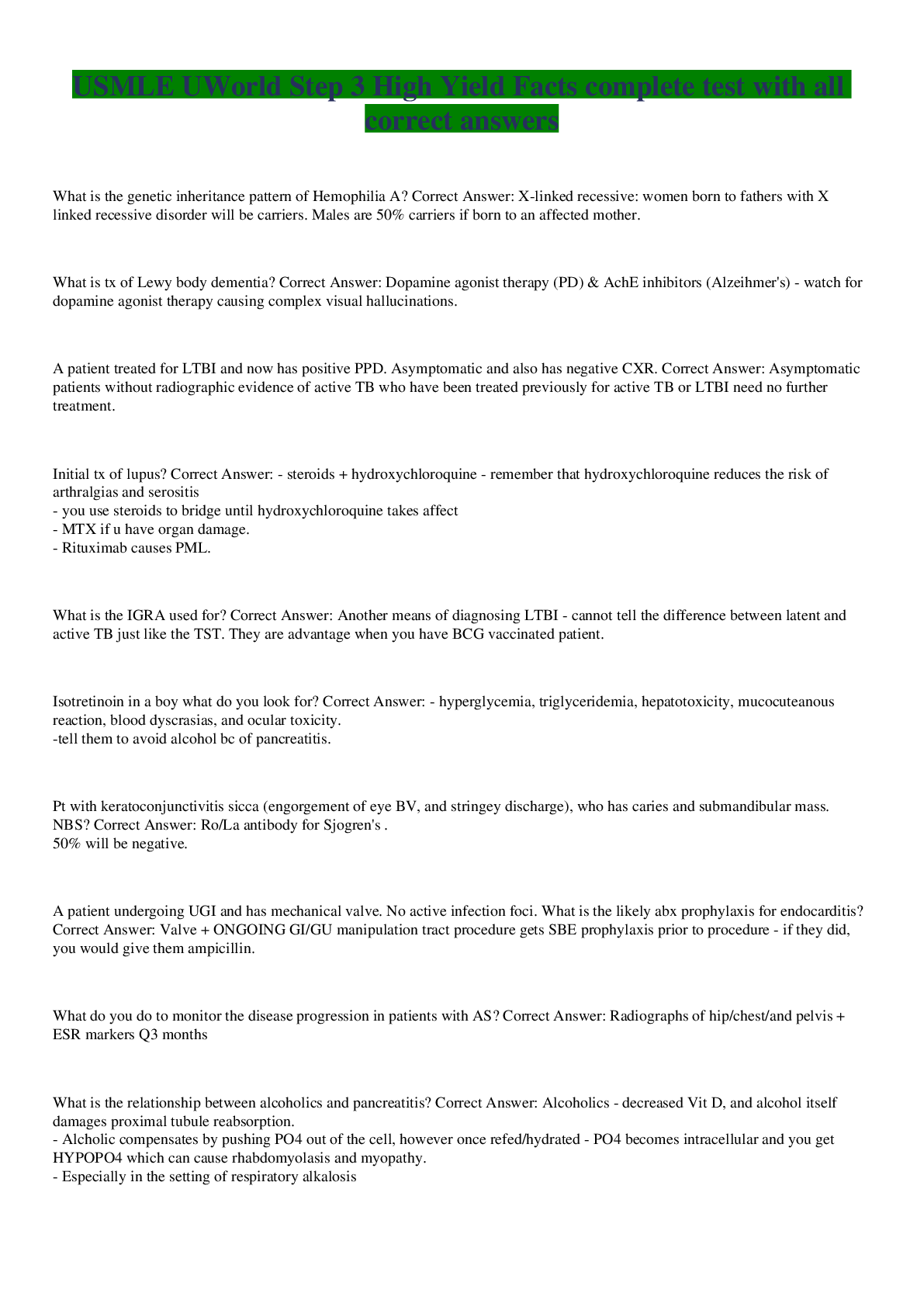
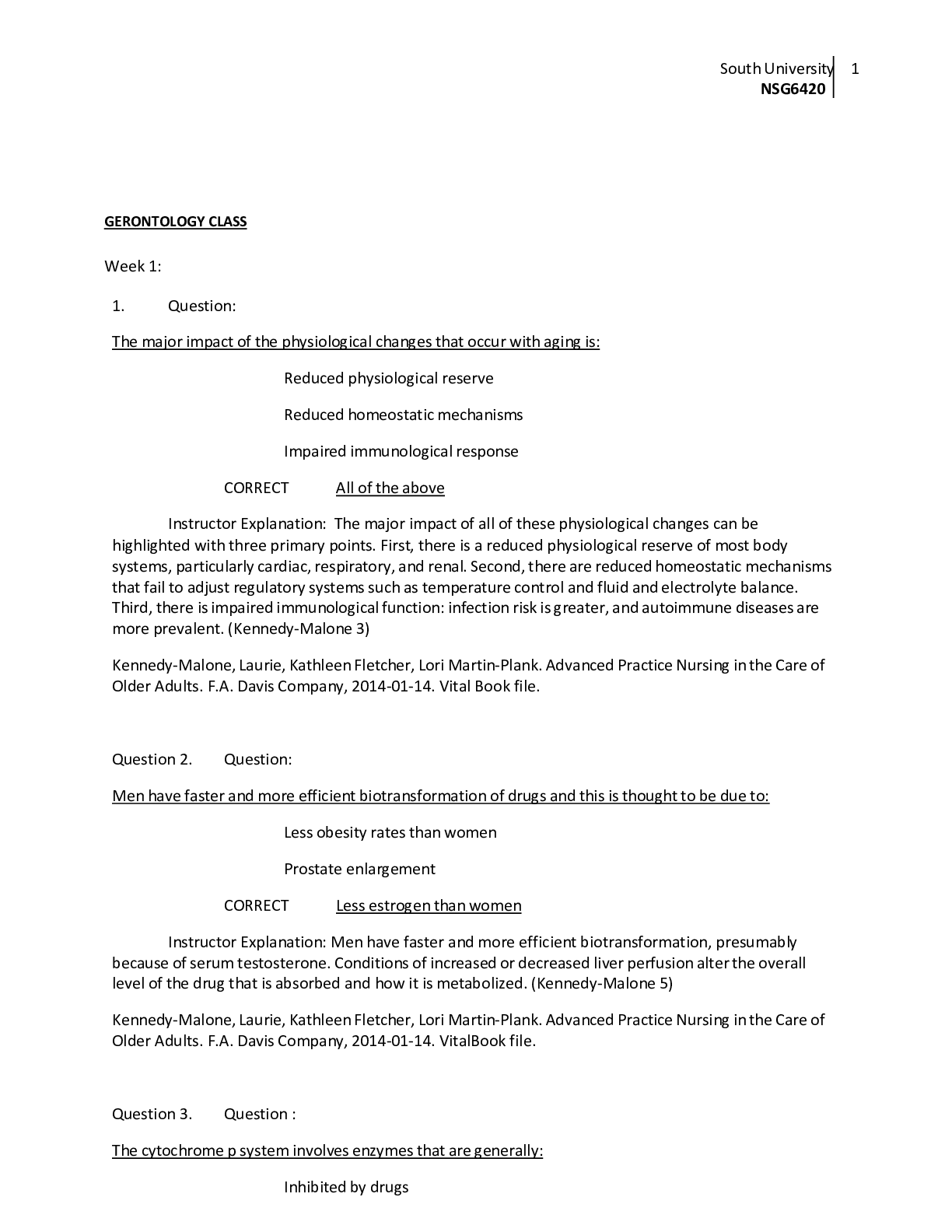
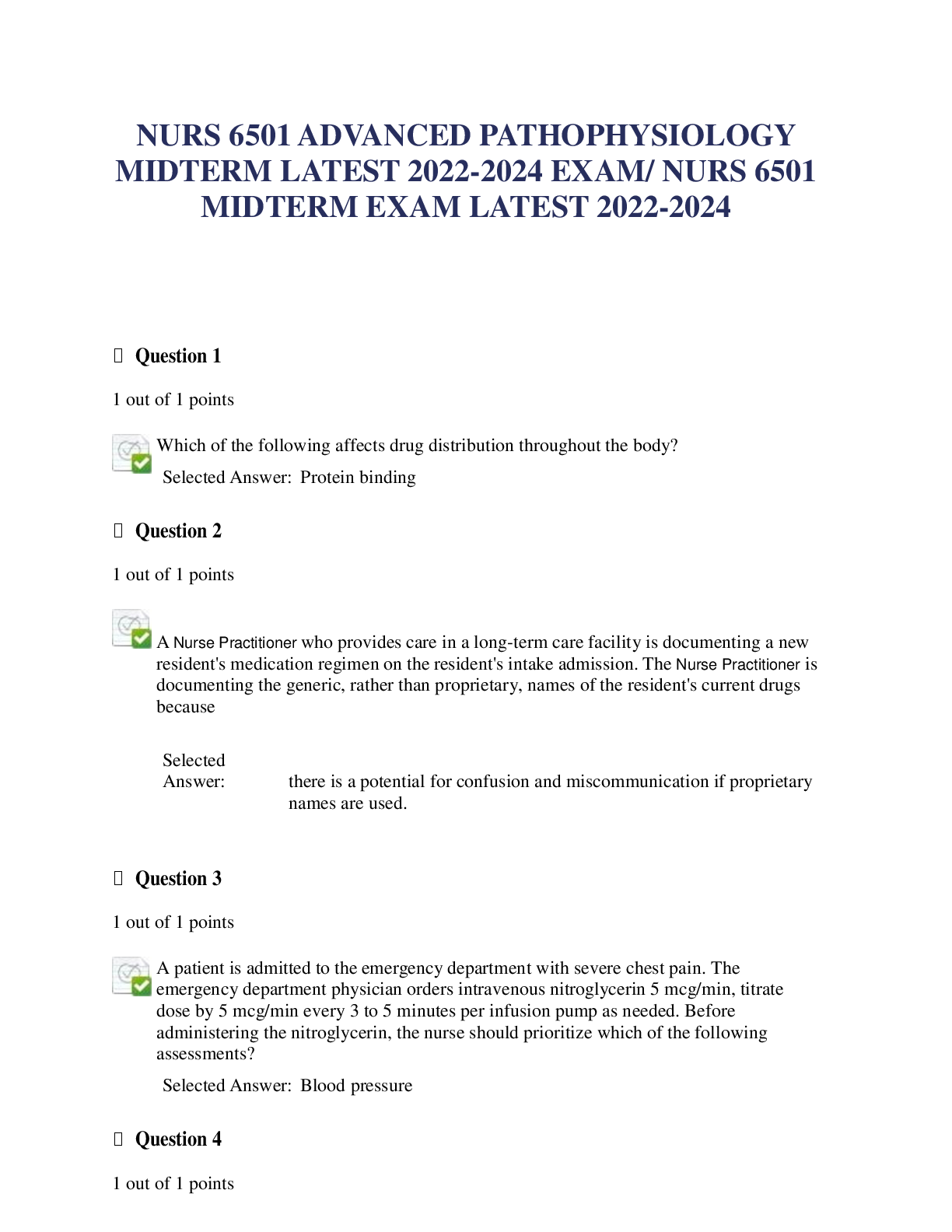
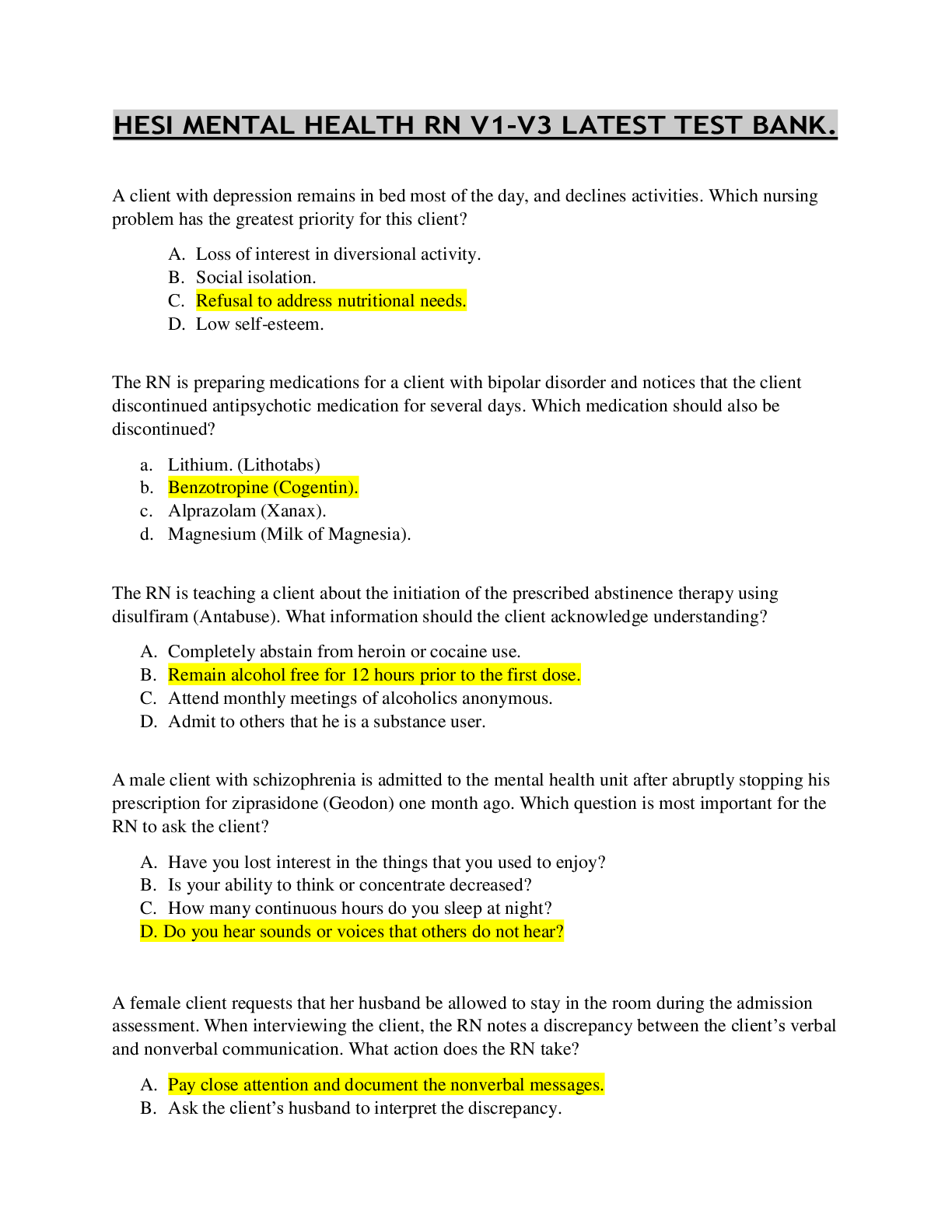
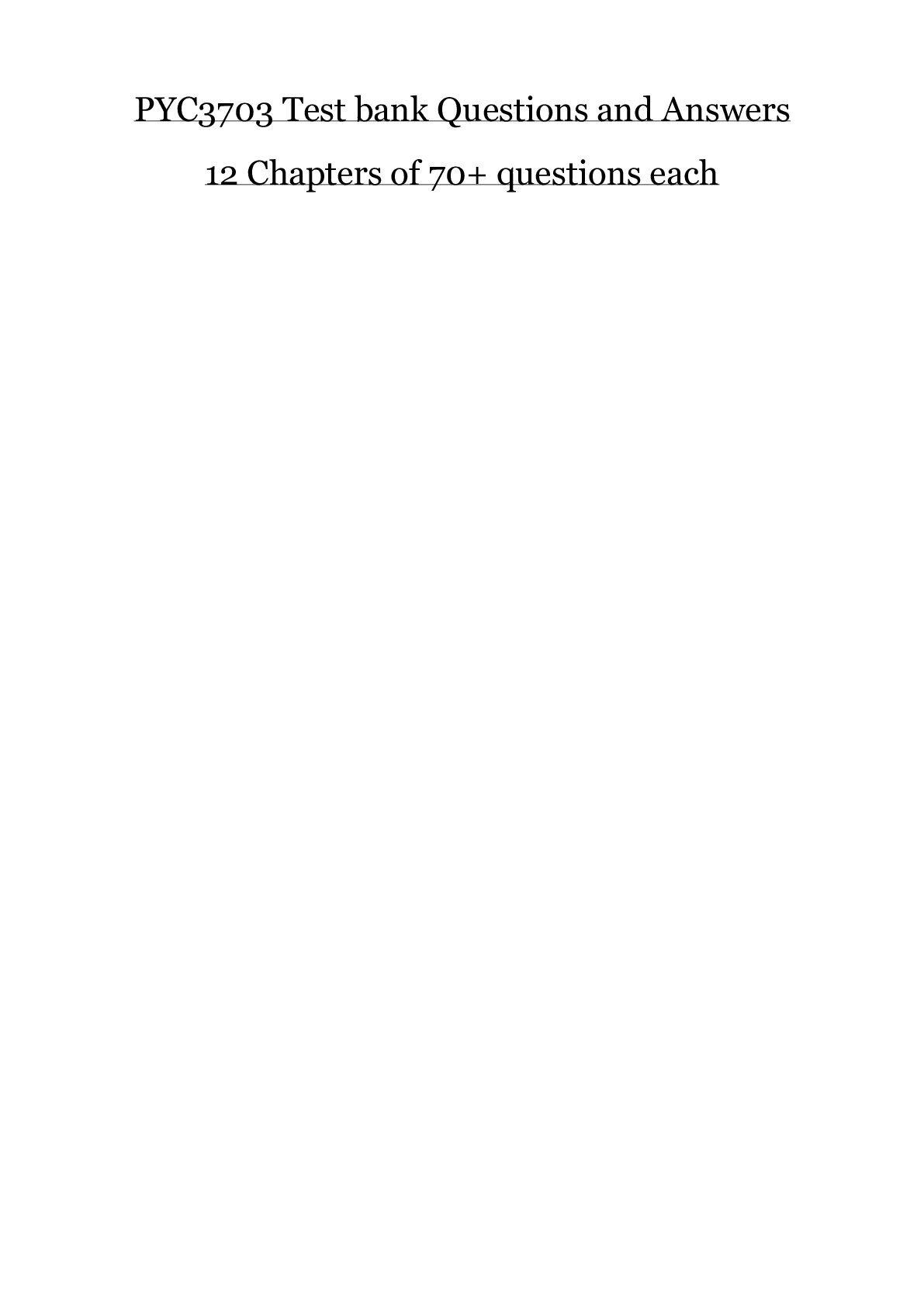
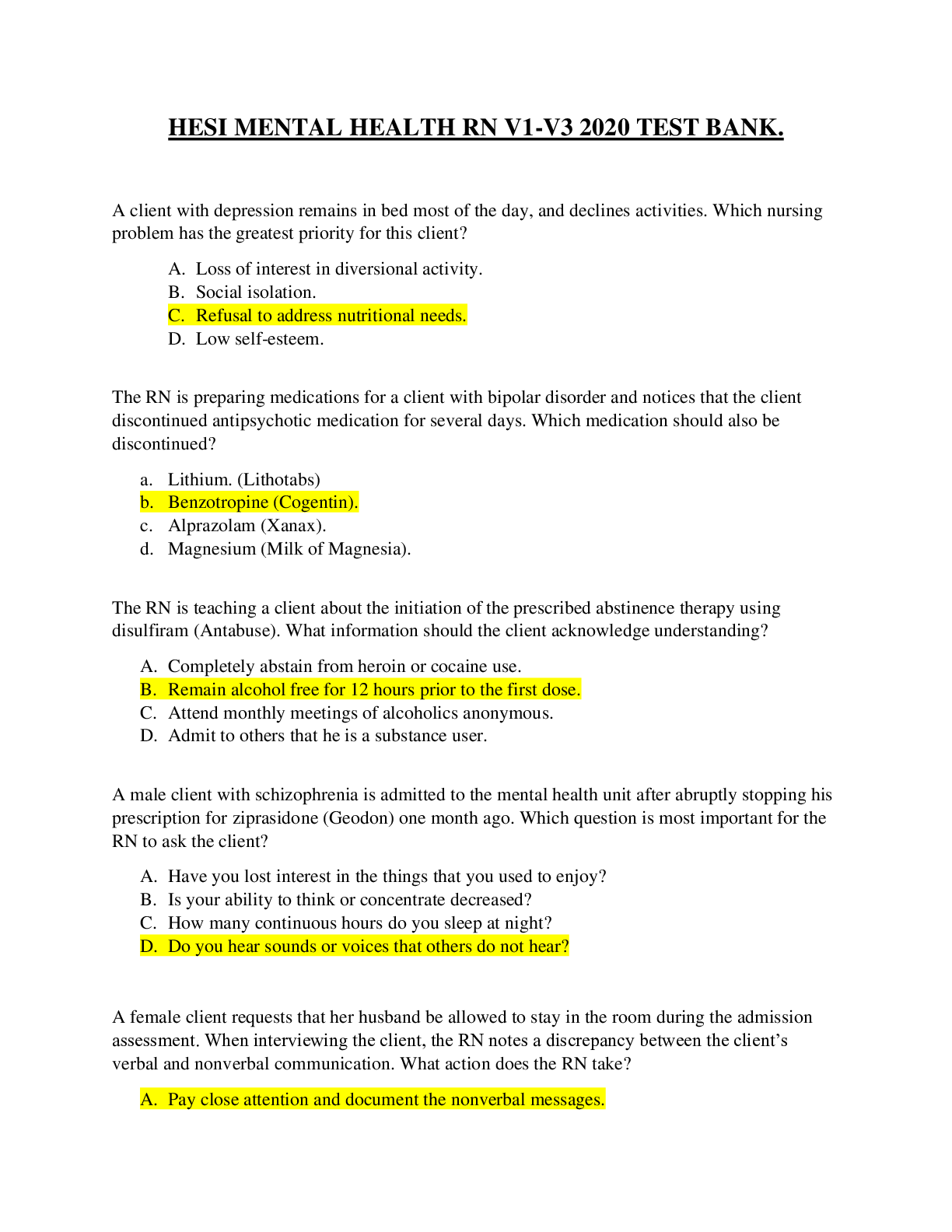
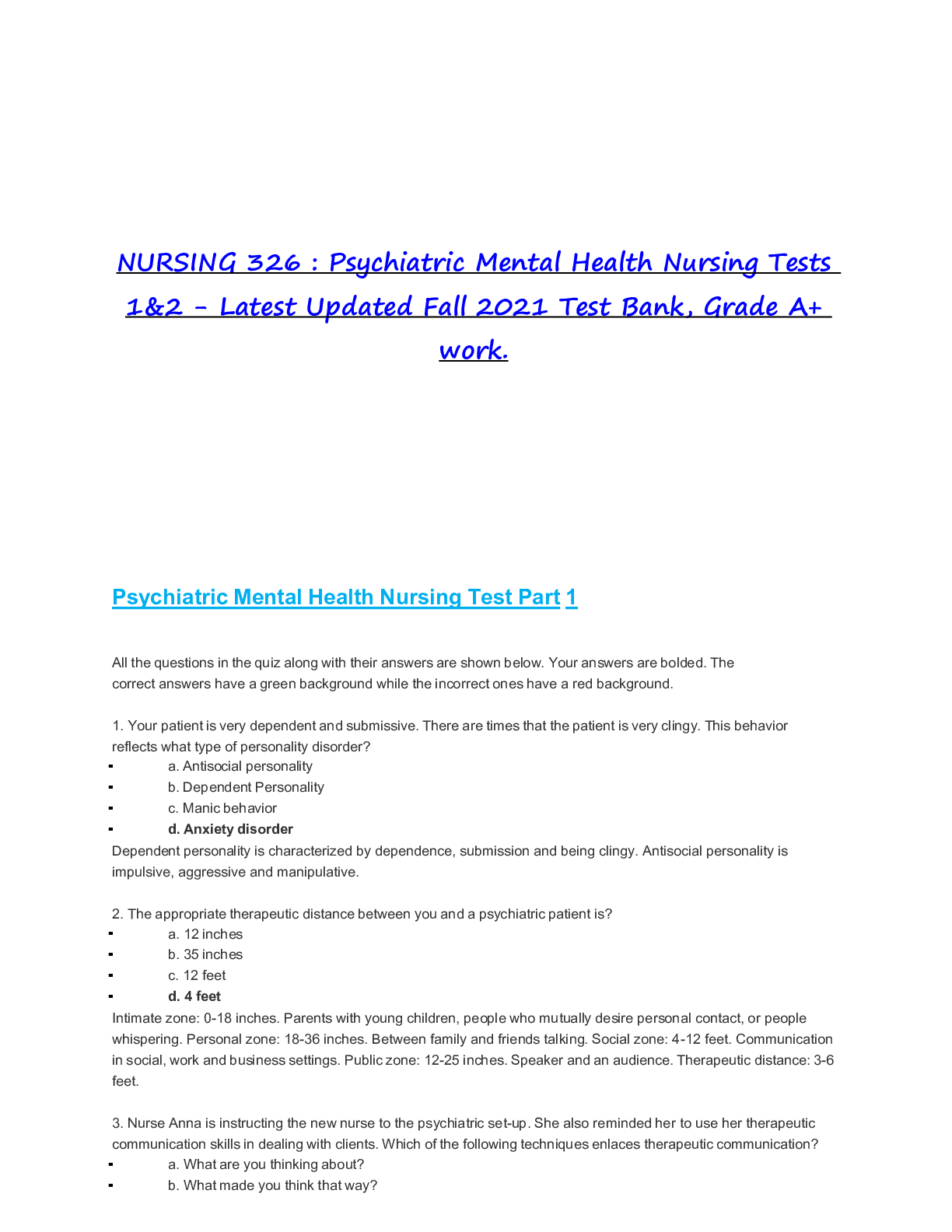
 with all correct answers.png)
